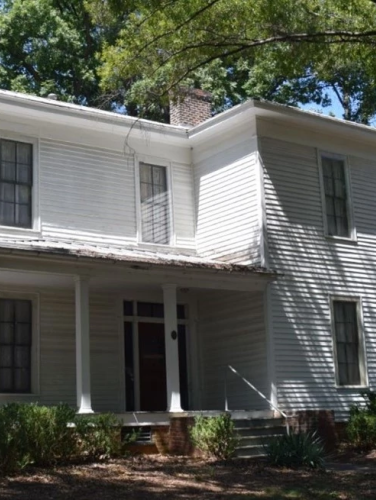
James C. Dowd House
(ca. 1879)
The James C. Dowd House was once the administrative headquarters for the U.S. Army’s WWI Camp Greene training facility.
2216 Monument St, Charlotte, NC 28208
In 1878, James Cornelius Dowd (1835-1898) purchased approximately 250 acres of land just west of Charlotte. He built the James C. Dowd House on that property in or around 1879. A native of Moore County, North Carolina, and a son of Confederate General Willis D. Dowd, James served as a captain in the North Carolina 45th Regiment during the Civil War. During the decade following that conflict, he migrated to Mecklenburg County with his first wife, Henrietta Rives (1843-1895), a native of Chatham County, North Carolina. The couple raised ten children, four girls and six boys, to adulthood. Among them were William Carey Dowd who bought The Charlotte News in 1895, and Willis Frank Dowd who established the Charlotte Pipe and Foundry Company in 1900. By the time of his death, James Dowd had become one of the most prominent farmers in Mecklenburg County. His second wife, Alice Livingston (1850-1900) of Huntersville, died in January 1900.
Property Quick Links
The Dowd farm was sold at public auction in 1899 and changed hands several times. Its owners included prominent Jewish merchant and entrepreneur Samuel Wittkowsky and local realtor and industrialist Robert M. Miller, Jr., who used a portion of the farm as the location for Elizabeth Mills, one of the community’s larger textile factories.
Following the United States’ 1917 entry into World War I, the Charlotte Chamber of Commerce appointed a committee to promote Charlotte as a potential location for an Army training camp. Major General Leonard Wood visited Charlotte in July of that year to tour the proposed site, comprised in large part of the former Dowd farm. Wood and his staff selected the site and decided to use the James C. Dowd House as the administrative headquarters for the camp that came to be named Camp Greene in honor of General Nathaniel Greene of Revolutionary War fame. The Dowd House served as the camp’s headquarters for approximately six months, primarily housing the personnel who directed and supervised construction of the camp. In 1924, following the closure of Camp Greene, I. M. Cook purchased the Dowd House. The property subsequently changed hands several times before being converted into commercial office space.

